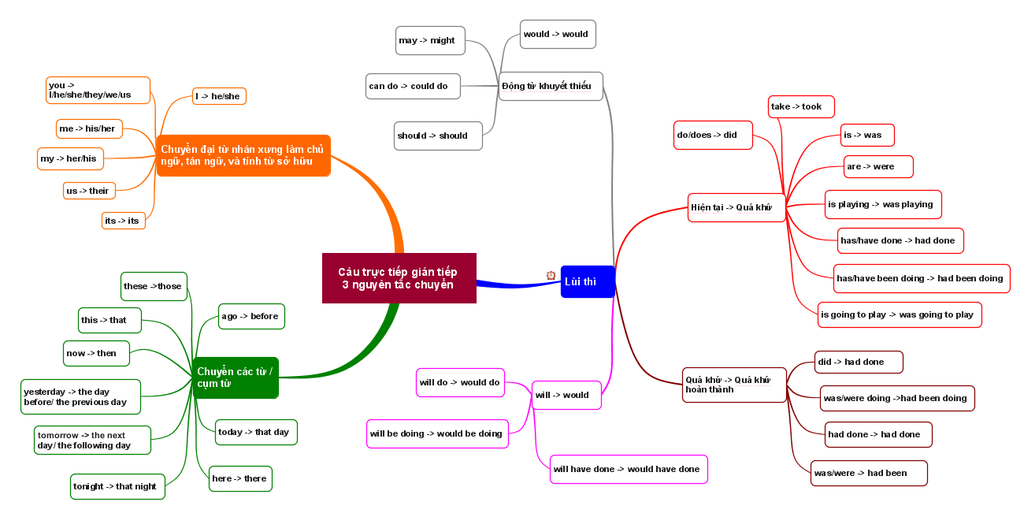2 câu trả lời
I. Khái niệm:
Lời nói trực tiếp (direct speech) là sự lặp lại chính xác những từ của người nói.
Lời nói gián tiếp (indirect/reported speech) là lời tường thuật lại ý của người nói, đôi khi không cần phải dùng đúng những từ của người nói.
II.3 nguyên tắc cần nhớ khi chuyển từ câu trực tiếp sang gián tiếp:
Đổi ngôi, đổi tân ngữ
Lùi thì
Đổi cụm từ chỉ thời gian, nơi chốn
Cụ thể như sau:
Rule (Quy tắc)
Direct speech (Trực tiếp)
Reported speech (Gián tiếp)
1. Tenses
(Thì)
Present simple (V/Vs/es)
Hiện tại đơn
Past simple (Ved)
Quá khứ đơn
Present progressive (is/am/are+Ving)
Hiện tại tiếp diễn
Past progressive (was/were+Ving)
Quá khứ tiếp diễn
Present perfect (have/has+VpII)
Hiện tại hoàn thành
Past perfect (had+VPII)
Quá khứ hoàn thành
Past simple (Ved)
Quá khứ đơn
Past perfect (had +VpII)
Quá khứ hoàn thành
Past progressive (was/were +Ving)
Quá khứ tiếp diễn
Past progressive/
Past perfect progressive (had +been +Ving)
Quá khứ tiếp diễn / Quá khứ hoàn thành tiếp diễn
Past perfect
Quá khứ hoàn thành
Past perfect
Quá khứ hoàn thành
Future simple (will +V)
Tương lai đơn
Future in the past (would +V)
Tương lai trong quá khứ
Near future (is/am/are +going to+V)
Tương lai gần
Was/were +going to +V
2. Modal verbs
(Động từ khuyết thiếu)
Can
May
Must
Could
Might
Must/Had to
3. Adverb of place
(Trạng từ chỉ nơi chốn)
This
That
That
That
These
Those
Here
There
4. Adverb of time
(Trạng từ chỉ thời gian)
Now
Then
Today
That day
Yesterday
The day before/ the previous day
The day before yesterday
Two days before
Tomorrow
The day after/the next (following) day
The day after tomorrow
Two days after/ in two days’ time
Ago
Before
This week
That week
Last week
The week before/ the previous week
Last night
The night before
Next week
The week after/ the following week
5.Subject/Object
(Chủ ngữ/tân ngữ)
I / me
She, he /Her, him
We /our
They/ them
You/you
I, we/ me, us
III. Cách chuyển câu trực tiếp sang câu gián tiếp
1.Câu trực tiếp ở dạng câu kể/tường thuật:
Câu gián tiếp:
S +
said
said to sb
told sb
that +
Clause
VD:
“I’m going to visit Japan next month”, she said. → She said that she was going to visit Japan the following month.
“He picked me up yesterday”, Lan said to me. → Lan said to me that he had picked her up the day before.
2.Câu trực tiếp ở dạng câu hỏi
Câu hỏi Yes/No question
Câu hỏi Yes/No question là câu hỏi mà người nghe sẽ phải lựa chọn trả lời Yes/No cho mỗi câu hỏi.
Câu gián tiếp:
S +
asked
asked sb
wondered
wanted to know
if
whether
+ Clause
VD:
“Do you love English?”, the teacher asked. → The teacher asked me if/whether I loved English.
“Have you done your homeworked yet?”, they asked. → They asked me if/whether I had done my homework yet.
Lưu ý: Nếu trong câu trực tiếp có từ “OR NOT” thì câu gián tiếp bắt buộc phải dùng WHETHER
“Does she like roses or not?”, he wondered. → He wondered whether she liked roses or not.
Câu hỏi Wh-questions
Câu hỏi Wh-questions là câu hỏi bắt đầu bằng từ hỏi Wh- (What, Where, When, Which, Why, How…)
Câu gián tiếp:
S +
asked
asked sb
wondered
wanted to know
+ Clause (Wh-word + S + V(thì))
(Lưu ý: Không đảo ngữ trong vế này)
VD:
“Where do you live, Nam?”, asked she. → She asked Nam where he lived.
3. Câu trực tiếp ở dạng câu mệnh lệnh (Vinf/ Don’t + Vinf, please)
Câu gián tiếp:
S +
asked/told/ordered/advised/wanted/warned
+ sb + (not) to Vinf
VD:
“Open the book page 117, please”,the teacher said. → The teacher asked us to open the book page 117.
“Don’t touch that dog”, he said. → He asked/told me not to touch that dog.


